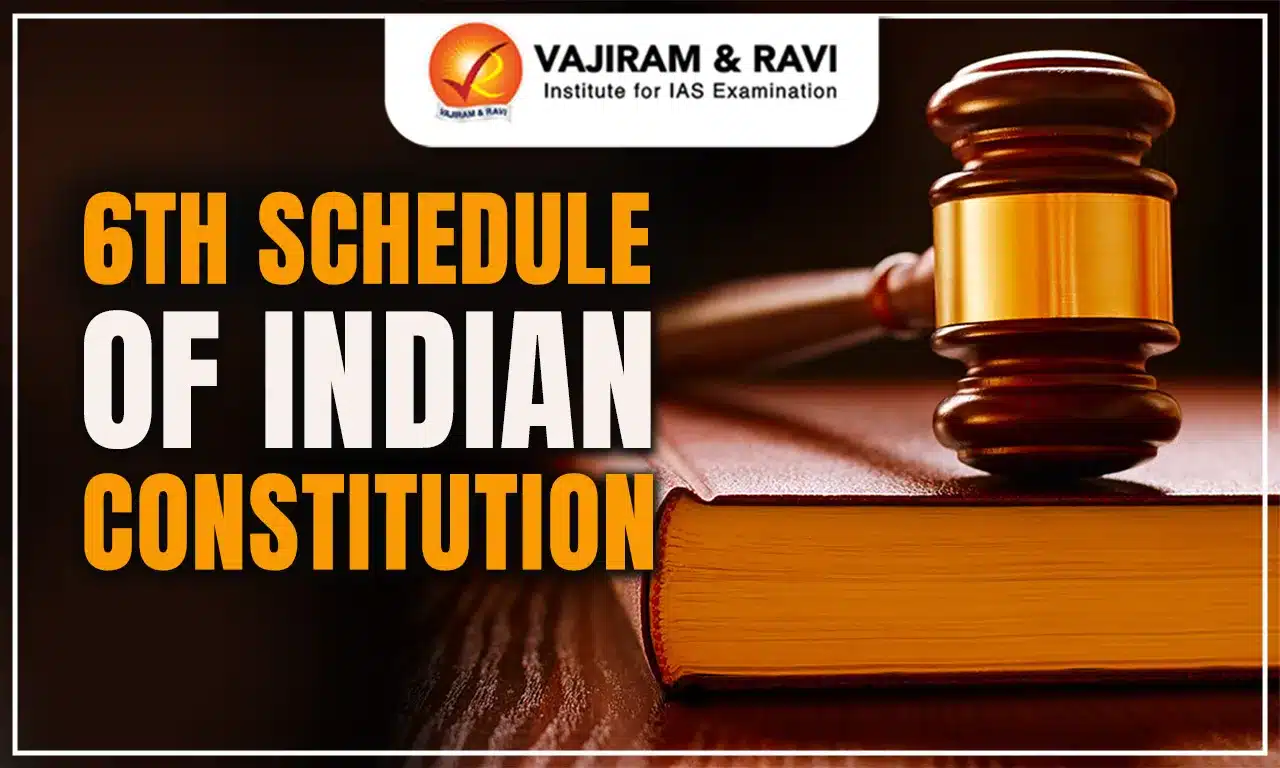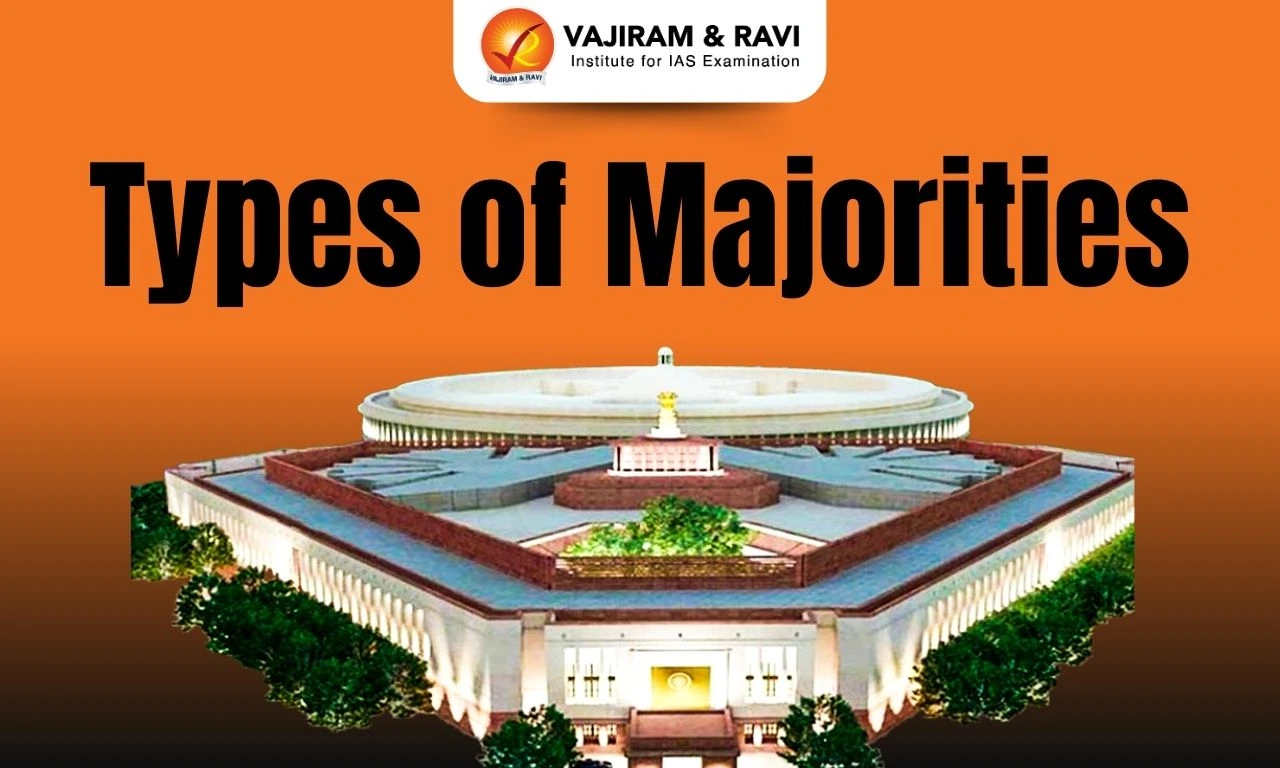6th Schedule of Indian Constitution Objectives
The objectives of the Sixth Schedule of the Indian constitution are:
- To provide for the administration of tribal areas in the northeastern states of Assam, Meghalaya, Tripura, and Mizoram.
- To protect tribal land and resources and prohibits the transfer of such resources to non-tribal individuals or communities.
- To ensure the tribal communities are not exploited or marginalized by non-tribal populations and that their cultural and social identities are preserved and promoted.
6th Schedule of Indian Constitution Provisions
The significant provisions of the Sixth Schedule are as follows
- Article 244(2): The provisions of the Sixth Schedule shall apply to the administration of the tribal areas in the States of Assam, Meghalaya, Tripura, and Mizoram.
- Autonomous districts and autonomous regions:
- The tribal areas in the four states of Assam, Meghalaya, Tripura, and Mizoram are to be administered as Autonomous Districts.
- If there are different Scheduled Tribes in an autonomous district, the Governor can divide the district inhabited by them into Autonomous Regions.
- The Governor is empowered to organize and reorganize the autonomous districts. He can also increase, decrease the boundaries or alter the name of any autonomous district.
- Constitution of District Councils and Regional Councils:
- There shall be a District Council for each autonomous district consisting of not more than 30 members, of whom not more than four persons shall be nominated by the Governor, and the rest shall be elected on the basis of adult suffrage.
- There shall be a separate Regional Council for each area constituted an autonomous region.
- Powers of the District Councils and Regional Councils to make laws:
- The District and Regional councils are empowered to make laws on certain specified matters like lands, management of forest (other than the Reserved Forest), inheritance of property, etc.
- These councils also empowered to make law for the regulations and control of money-lending or trading by any person other than Scheduled Tribe residents in that Scheduled District.
- However, all laws made under this provision require the assent of the Governor of the State.
- Administration of justice in autonomous districts and autonomous regions:
- The District and Regional Councils are empowered to constitute Village and District Council Courts for the trial of suits and cases where all parties to the dispute belong to Scheduled Tribes within the district.
- The High Courts have jurisdiction over the suits and cases which is specified by the Governor.
- However, the Council Courts are not given the power to decide cases involving offenses punishable by death or imprisonment for five or more years.
- The District and Regional Councils are empowered to assess and collect land revenue and impose taxes on professions, trades, animals, vehicles, etc. The Councils are given the power to grant licenses or leases for the extraction of minerals within their jurisdiction.
- The District Councils and Regional Councils are given the power to establish, construct or manage primary schools, dispensaries, markets, cattle ponds, fisheries, roads, road transport and waterways in the districts.
- To autonomous districts and autonomous regions, the acts of Parliament or the state legislature do not apply or apply with specified modifications and exceptions.
- The Governor can appoint a commission to investigate and provide a report on any issue pertaining to the management of the autonomous districts or regions.
6th Schedule of Indian Constitution States
| Assam |
|
| Meghalaya |
|
| Tripura |
|
| Mizoram |
|
What are the issues pertaining to the 6th Schedule?
There are several issues pertaining to the Sixth Schedule:
- Different tribal populations under a single autonomous council: Within a single autonomous council, there are various tribal populations with various cultures and customs.
- For example, In North Cachar Hills district, which was renamed Dima Hasao, there are 13 tribes; the major tribal groups are Dimasa, Kuki, Zeme, Hmar and Karbi.
- Insufficient allocation of funds: The Members of Chakma, Lai, and Mara Councils are of the view that the funds provided by the Central Government are insufficient and that funds should be distributed to local councils on the basis of their level of backwardness rather than their population.
- Inadequate devolution of power: While the Autonomous district councils(ADCs) have been granted significant powers to make laws, the state governments still have a significant role in the administration of these areas, which limits the effectiveness of the ADCs.
- Inter-tribal conflicts: The ADCs are meant to represent the interests of all tribal communities in a district, but sometimes, the political process of electing members to the ADCs can lead to conflicts between different tribal groups.
- Corruption and lack of accountability: In the functioning of the ADCs, there have been allegations of corruption and misuse of funds. Hence, There is a lack of transparency and accountability in their functioning.
- Lack of awareness and participation: Many tribal communities are not fully aware of the provisions of the Sixth Schedule and their rights under it. This can lead to a lack of participation in the political process and a limited understanding of the benefits of the ADCs.
Recent Demand from Ladakh:
- In the last couple of years, Ladakh has been the location of many developmental projects. These include India’s first geothermal power plant and green hydrogen unit. Seven hydropower projects are also proposed to be built on the Indus river and its tributaries.
- These rapid development projects challenge the fragile ecosystem of Ladakh. To protect the fragile ecosystem of Ladakh, Ladakhis have demanded their region’s inclusion in the Sixth Schedule of the Indian Constitution.
- Ladakh also has a tribal population of more than 97 percent, fulfilling the criteria for Sixth Schedule status.
What steps could be taken for the effective implementation of the 6th Schedule?
- Strengthening of Autonomous District Councils: The ADCs should be strengthened with adequate resources, administrative and financial powers, and personnel to ensure effective functioning.
- Removing disparity among council: It is essential to take effective measures for the elimination of disparity among council, state, and central functions so that the provisions established for the Tribal people in the sixth schedule can be effectively implemented for their better future.
- Inclusion of more areas: The scope of the Sixth Schedule should be expanded to include more areas with a substantial tribal population. This would help in protecting the rights and interests of the tribal people and promoting their development.
- Increase autonomy: The autonomous district councils (ADCs) established under the Sixth Schedule should be given more powers to manage their affairs independently. This would help in empowering the tribal communities and promoting their development.
- Encouraging community participation: The involvement of local tribal communities in the decision-making process is crucial for the effective implementation of Sixth Schedule.
- Regular monitoring and evaluation:
- The government should conduct regular monitoring and evaluation of the implementation of the Sixth Schedule.
The government can establish a body or committee that can monitor all the budget allocation activities in different areas specified under schedule so that such areas can get equal opportunities for growth and development.
| Other Related Posts | |
| Important Articles of Indian Constitution | 9th Schedule |
| Schedules of Indian Constitution | Anti Defection Law |
| 5th Schedule | Preamble of the Indian Constitution |
| 6th Schedule | |
Last updated on December, 2025
→ Check out the latest UPSC Syllabus 2026 here.
→ Join Vajiram & Ravi’s Interview Guidance Programme for expert help to crack your final UPSC stage.
→ UPSC Mains Result 2025 is now out.
→ UPSC Notification 2026 is scheduled to be released on January 14, 2026.
→ UPSC Calendar 2026 is released on 15th May, 2025.
→ UPSC Prelims 2026 will be conducted on 24th May, 2026 & UPSC Mains 2026 will be conducted on 21st August 2026.
→ The UPSC Selection Process is of 3 stages-Prelims, Mains and Interview.
→ UPSC Result 2024 is released with latest UPSC Marksheet 2024. Check Now!
→ UPSC Toppers List 2024 is released now. Shakti Dubey is UPSC AIR 1 2024 Topper.
→ Also check Best IAS Coaching in Delhi
6th Schedule of Indian Constitution FAQs
Q1. How is the Sixth Schedule different from the Fifth Schedule?+
Q2. What is the role applies to tribal areas in various states of India, excluding Assam, Meghalaya, Tripura, and Mizoram. e of the District Council under the Sixth Schedule?+

















